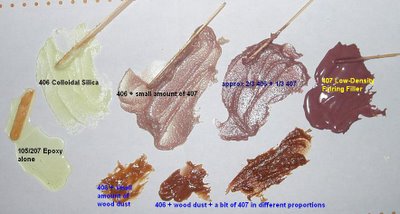The 406 filler is "colloidal silica" adhesive filler, particularly good for gluing things together (like laminated stems), and is made of extremely small particles of silica. It was available in two sizes, 1.7 ounce or 5.5 ounce. Well 1.7 oz doesn't sound like a heck of a lot for something you mix in by the handful to thicken a batch of epoxy so I figured I'd better get the larger size. Well I now own a tub of colloidal silica. This stuff is light! It looks like very fine, very light, white snow. It literally floats out of the container on it's own when you open the lid.
The 407 filler is the "low density fairing filler" and is intended for filling gaps or hollows and can be sanded easily and isn't heavy. It's also purple. Here's how West System describes it:
407 Low-Density filler is a blended microballoon-based filler used to make fairing putties that are easy to sand or carve. Reasonably strong on a strength-to-weight basis. Cures to a dark red/brown color.
Sounds like it should be perfect and blend fairly well with the darker wood on the kayak to fill all those gaps where my joints weren't perfect right? Perhaps if my boat was built of purple heart.
In order to have some idea of how the epoxy and fillers could be combined to get a variety of colours to match the wood on my boat I mixed up a few batches in different combinations to see what shades I can come up with. I also collected half a large peanut butter container of the dust left over from the sander. The problem with using wood flour is that it continues to absorb epoxy after it's mixed to the desired consistency, it ends up being heavy and hard to sand because the fibers are saturated with epoxy, and it has a colour much darker than the original wood.

 The silica in the mix seems to give everything sort of a silvery hue. The 406 has quite a yellowish appearance when mixed with the epoxy and this will actually probably match fairly well with the yellow cedar at the front of the deck. In order to match the rest of the wood I'll probably end up using mostly 406 with a bit of wood flour mixed in for the brown colour, and a very small amount of the 407 stuff in areas that are a bit darker. Flour can also be used as a an additive to lighten the colour so I might play with this a bit too; maybe rye flour would have a bit of brown colour?
The silica in the mix seems to give everything sort of a silvery hue. The 406 has quite a yellowish appearance when mixed with the epoxy and this will actually probably match fairly well with the yellow cedar at the front of the deck. In order to match the rest of the wood I'll probably end up using mostly 406 with a bit of wood flour mixed in for the brown colour, and a very small amount of the 407 stuff in areas that are a bit darker. Flour can also be used as a an additive to lighten the colour so I might play with this a bit too; maybe rye flour would have a bit of brown colour?The putties mixed for the above picture were all about the consistency of peanut butter or a bit thinner. It's interesting that the 407 filler gives a much smoother texture than the mixes that include the 406 silica.
No comments:
Post a Comment